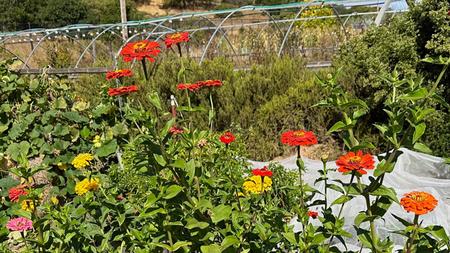News from the Edible Demo Garden
May 2024: Flowers and Edibles Make Good Neighbors

A variety of flowers are grown in the Edible Demo Garden. Some are perennials such as yarrow and lavender. Others are annuals that are grown from seed in the greenhouse and planted each year. These include zinnias, marigolds, and calendula. Then there are the flowering plants that self-seed and return on their own like the California poppies and the sunflowers. Sunflowers have been so successful in the Edible Demo Garden, that they sometimes show up where they are not wanted.
Favorite flowers for attracting pollinators

Flowering plants that discourage pests
There is increasing scientific-based evidence that certain plants are effective in managing pests in an edible garden. They can confuse pests, luring them away from their favorite target and disrupting their feeding and egg-laying behaviors. Studies have suggested that plants with strong odors can discourage pests by masking the scent of the desired host plant. Marigolds (Tagetes) have long been a pest-repelling favorite of gardeners, but the supporting science is scant. However, there is research showing their effectiveness against parasitic nematodes and some flies affecting vegetable crops. In addition to their ability to attract pollinators, Nasturtiums (Tropaeolum majus), have been found to reduce squash bug damage when grown with zucchini. Their edible flowers make them especially welcome in the garden.
The importance of diversity in the garden

The right flowers in an edible garden are not just ornamental, they balance the garden. They help in creating a habitat that supports plant growth and production and reduces the need for pesticides and other pest-management strategies.
Click here for more information about plants that attract pollinators.
